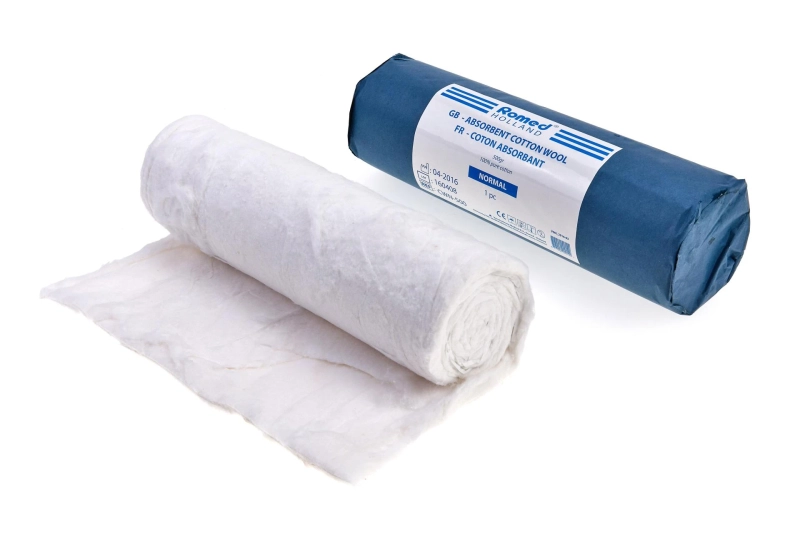In medical supply, pharmaceuticals and healthcare institutions, absorbent cotton wool remains one of the most essential consumables. It is used for wound care, first aid, surgical dressings, cosmetics and hygiene. For distributors, hospitals and care homes, understanding quality, standards, cost-efficiency and useful variations such as interleaved cotton wool can drive better procurement decisions, reduce wastage and ensure patient safety.
What is Absorbent Cotton Wool?
Absorbent cotton wool is a high-purity cotton fiber product refined for medical and hygiene uses. It is processed by removing natural waxes and oils, cleaning, bleaching, carding and sometimes sterilising. The result is soft, fluffy cotton that has high fluid absorption. It is often referred to in institutional settings as surgical cotton or medical cotton.
Characteristics include:
- Soft texture with minimal irritation risk
- High absorbency of blood, exudates or other fluids
- Free from impurities: seeds, leaf fragments, dust
- Fibre length and uniform staple quality for consistency in performance
What Does “Interleaved” Mean in Cotton Wool?
Interleaved cotton wool refers to layers of cotton wool separated by thin sheets (often paper or equivalent) to prevent matting and maintain shape. These interleaved layers:
- Allow easier separation and use in clean settings
- Help maintain sterility during handling
- Keep cotton fluffy so absorption is uniform
- Reduce sticking together when packaged
For B2B buyers, interleaved products are typically preferred in surgical theatres, clinics or where high throughput and sterile presentation are required.
Uses and Applications in Healthcare and Institutional Settings
Institutions use absorbent cotton wool (both interleaved and non-interleaved) in many ways:
- Dressing wounds, applying antiseptics or cleaning cuts
- Absorbing bleeding or exudate during surgical procedures
- Swabbing, cleaning skin before injections or minor operations
- Cosmetic & facial procedures in dermatology clinics
- Gentle cleaning tasks in neonatal care or baby care units
- Use in first aid kits or emergency carts
Interleaved cotton wool is especially useful when open, sterile presentation is required (for example, in surgery or when preparing dressings in operating theatres).
Quality Parameters to Evaluate
When procuring absorbent cotton wool, institutional buyers should check specific quality features:


Key Benefits for Institutional Buyers
Understanding the advantages helps procurement teams justify costs and optimise usage. Key benefits include:
- Improved Infection Control
- Cotton wool of high purity, properly sterilised and interleaved, reduces risk of cross-contamination.
- Efficient Usage
- High absorbency means fewer changes of dressing or swabs, resulting in lower overall supply usage.
- Ease of Handling
- Interleaved cotton wool allows staff to pick up clean sections without touching the whole mass, maintaining hygiene.
- Cost Savings Over Time
- Although higher-quality or interleaved versions may carry a slightly higher unit price, reduced waste, fewer dressing changes, and better patient comfort lead to overall savings.
- Versatility
- Useful in multiple departments: emergency, surgery, dermatology, maternity, baby care, cosmetic units etc. One product line can serve many needs.
- Regulatory & Compliance Assurance
- Institutions that adhere to medical procurement and hygiene regulations benefit from using certified and approved cotton wool. This helps in audits, accreditation and risk management.
Differences Between Standard and Interleaved Cotton Wool

How to Use and Store Properly
Proper usage improves performance and reduces waste. For institutional use:
- Store in dry, clean environment; avoid moisture or dust
- Use gloves when handling to prevent contamination
- Keep packaging closed until needed; use interleaved outer sheets if available
- Ensure proper disposal of used cotton; medical waste protocols must be followed
- Train staff on how to use cotton wool in different clinical contexts to prevent overuse
Bulk Buying and Supplier Considerations
For institutional procurement, following factors are crucial:
- Supplier that provides certified test reports and quality assurance
- Transparent pricing for different pack sizes / per-unit cost
- Good lead times, stable supply chain and inventory support
- Packaging that meets sterility and transport requirements
- Labelled met - weight, batch number, compliance with standard norms
Potential Challenges and How to Address Them
- Inconsistent Quality: Some supplies may have variable absorption or contain impurities. Solution: insist on inspection, sample testing.
- Supply Delay: Raw cotton shortages or manufacturing lag can cause delays. Solution: build buffer stock; identify alternate suppliers.
- Storage Conditions Affecting Product: High humidity or heat may degrade cotton. Solution: proper warehouses; sealed packaging.
- Waste from Non-interleaved Packs: Using loose wool can lead to wastage or contamination. Solution: prefer interleaved versions for critical departments.
Choosing the Right Supplier
Institutional buyers should follow a clear checklist when selecting:
- Has long experience in manufacturing or supplying medical absorbent cotton wool
- Provides options for interleaved packaging and various pack sizes
- Meets local and international medical/hygiene standards
- Offers sample testing and after-sales support
- Can supply stable quantities, fast lead times and good price breaks for volume
Conclusion
For hospitals, clinics, care homes and health authorities, absorbent cotton wool and especially absorbent cotton wool interleaved are staples in medical and hygiene care. Choosing high-quality, pure cotton, certified and properly packaged versions ensures patient safety, reduces waste and enhances operational efficiency.
When seeking trusted, certified suppliers with superior product range and consistent quality, consider the offerings of ROMED HOLLAND.



